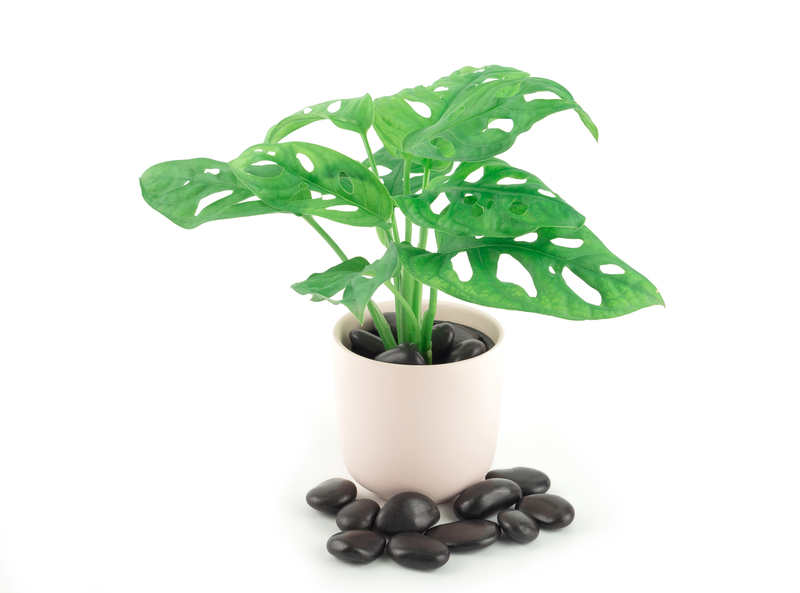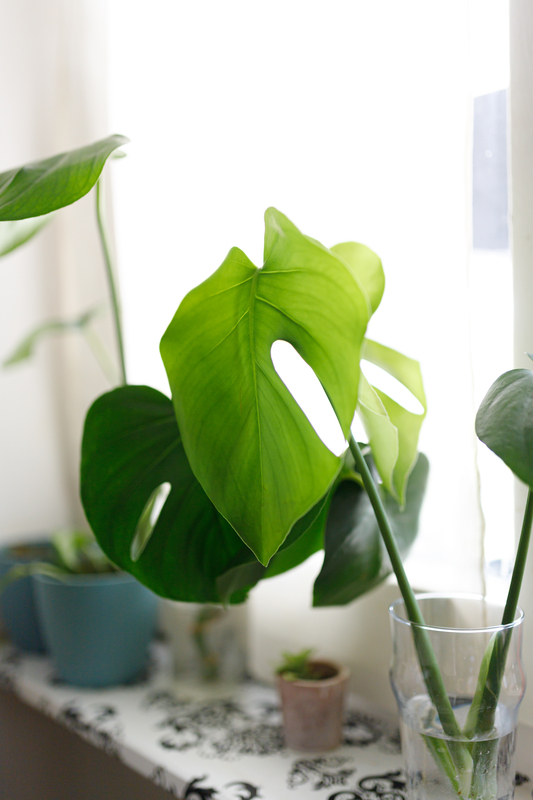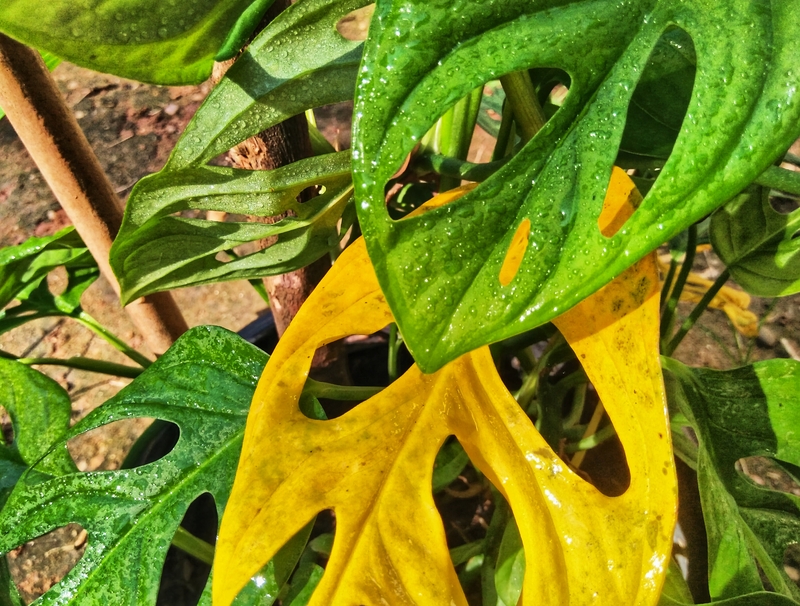HousePlantJoy is supported by our audience. When you purchase through one of our links, we may earn a small affiliate commission. As an Amazon Associate I earn from qualifying purchases. Your cost is not affected.
==================
Are you new to gardening and are looking for an undemanding yet peculiar houseplant? A Swiss cheese plant is perfect for both novice and experienced gardeners. Here’s an in-depth guide to Swiss cheese plant care!
Thriving Swiss Cheese Plants: Your Complete Care Guide
The Swiss cheese plant is an aesthetic houseplant featuring attention-grabbing leaves. As a woody wine, Swiss cheese abundantly grows in North and South America, growing as high as 70 feet tall. Yet, it is also a popular houseplant due to easy Swiss cheese plant care and few pests and diseases.
Swiss Cheese in a white pot indoors
Also, the funny name comes from the beautiful leaves of Swiss cheese that get holes. The leaves can be as broad as three feet, making them an excellent addition to adding greenery in any indoor space.
We cover everything from Swiss cheese plant watering to general care advice and propagation. Our article even discusses how to remedy yellowing leaves. Continue reading to learn more.
Swiss Cheese Plant Description
The Swiss cheese plant (Monstera adansonii) is an epiphyte. The plant has its origins in the rainforests of South America. Even though Swiss cheese has flowers, it is grown indoors for its tall, eye-catching leaves. Once it matures, it can serve as a focal point indoors.
Swiss cheese plant care
The plant survives strong winds and heavy rains because to its beautiful leaves with holes. Indoor plants with thick, broad leaves are vulnerable to severe weather.
Swiss cheese plant care is easy, and the plant is not so demanding. But, providing suitable conditions and following the proper instructions are still essential. For instance, if you don’t mind regular Swiss cheese plant watering, it can force your plant to lose its charm.
Monstera adansonii, like Monstera deliciosa, is a tropical perennial. It also grows quickly and has a trailing habit. Yet, when cultivated as an indoor container plant, people can maintain Swiss cheese at a reasonable height.
Moreover, young nursery plants are ideal for cultivating Swiss cheese; you can pot it anytime. Even though it has few pests or diseases, the Swiss cheese plant’s yellow leaves are the most common issue gardeners run into. Too much light, too much water, the wrong temperature, and other factors could cause these things. So, while not demanding, Swiss cheese plant hydration and proper conditions are necessary. With them, optimal growth becomes achievable.
It is worth noting that despite being a stunning addition, all parts of the Swiss cheese plant are toxic to pets. So ensure to keep your furry friends away from your plant.
Swiss Cheese Plant Care
Before discussing the Swiss cheese plant propagation process, knowing how to keep your houseplant healthy is essential
Although this houseplant is easy to care for and has minimal needs, providing it with food and the right conditions will keep potential problems like Swiss cheese plant yellow leaves at bay. Also, occasional pruning is also necessary to control your plant’s growth indoors. Here are a few essential Swiss cheese plant care tips:
Swiss Cheese Plant Light Needs
Since the Swiss cheese plant is native to tropical regions where it grows abundantly under sunlight, the houseplant prefers bright, indirect light indoors. Moreover, large trees protect these plants from direct sunlight in the wild, helping them to produce stunning foliage.
Broad, Split Leaves of Monstera Adansonii
So, if you plan to grow these plants indoors, keep them in a bright place but away from direct sunlight. Too much exposure to direct unfiltered sunlight is also a culprit that triggers Swiss cheese plant yellow leaves. But, if the direct sun is unescapable, limit your plant’s exposure to three hours of the morning sun.
Swiss Cheese Plant Soil Requirements
Rather than using regular potting mix for growing Swiss cheese, these plants thrive in a chunky, well-draining mix. While purchasing a pre-made aroid potting medium from your local garden center is an option, you can also prepare your potting medium by mixing peat-based potting, perlite, and orchid bark.
Moreover, peat moss potting mix is ideal for growing Swiss cheese indoors as it helps your plant to get adequate moisture without becoming waterlogged. For stronger growth, the pH of the soil should be between 5.5 and 7.
Swiss Cheese Plant Watering
Easy Swiss cheese plant care is one benefit that makes these houseplants ideal for novice gardeners. Since the plant has average water requirements, you should avoid overwatering to prevent the risk of the Swiss cheese plant’s yellow leaves. Also, overwatering could also make your houseplant more susceptible to root rot.
Nonetheless, Swiss cheese plants need weekly irrigation. Yet, during hot temperatures, it may need more frequent watering. Observing the soil is a smart way to determine if your houseplant is thirsty. If it feels slightly dry, it’s time to water.
Moreover, since these tropical perennials grow best in humid environments, you may also want to spray their leaves every other day to avoid the risk of Swiss cheese plant yellow leaves.
Temperature and Humidity
As mentioned earlier, Swiss cheese plants grow well in warm temperatures with high humidity. While these plants are grown in gardens in Central America, Swiss cheese is typically a houseplant and better suited for indoor growing – unless you are living in a tropical region.
Moreover, these houseplants thrive in temperatures between 18 to 30C, ensuring their leaves stay dark green. But, keeping your plant below 25C could cause problems like Swiss cheese plant yellow leaves, making it lose its charm. So, it will only last for a while if your houseplant has adequate temperature and humidity.
Fertilization
Swiss cheese likes fertilizer just like any other houseplant, especially if you are growing it in soil that doesn’t have much in it. Besides watering your Swiss cheese plant regularly and following other care tips, fertilizing and making changes to the soil help your plant get the nutrients it needs for strong growth.
Fertilizing your Swiss cheese helps it grow healthy roots and stems throughout the season. Also, the right fertilizer keeps your houseplant’s leaves rich and dark green, which is important because the leaves are so pretty.
When Is the Ideal Time to Fertilize Your Swiss Cheese?
The active growing season is the best time to feed your houseplant. Swiss cheese growing season comprises a significant part of spring, summer, and early fall. So, once winter is over, plan to feed your Swiss cheese every two to three weeks. Continue this practice until the fall and gradually reduce fertilization until you completely stop it in winter.
That said, you should aim to feed your houseplant with an N-P-K fertilizer with a ratio of 3-1-2. Or, a general-purpose fertilizer with an even blend of nutrients is also beneficial.
Swiss Cheese Pruning
Pruning is another essential Swiss cheese plant care factor. As we already know, the Swiss cheese plant has a climbing growth habit, so you should prune it when it starts to outgrow indoors. This will help you keep your houseplant to a size that is easy to care for and will also help it grow new leaves and grow bigger.
So, when should you prune your Swiss cheese plant?
If you plan to prune your houseplant indoors, you can do so throughout the year. But, the ideal pruning time is spring, when your plant’s growing season is about to start. Also, it is also imperative to determine how you want your houseplant to grow.
For instance, if you want it to grow healthier and fuller, you should aim to prune stems above the leaf nodes. This technique will encourage your Swiss cheese with new healthier leaf growth. Moreover, you may also want to remove any dead or damaged leaves.
Swiss Cheese Plant Propagation
Besides easy Swiss cheese plant care, the plant has a straightforward propagation process. In fact, it’s even easier to spread than the pothos, which loves to spread. You can put in place a few ways to propagate your houseplant.
Propagation of Monstera Adansonii
But before we jump into the propagation process, knowing what tools you will use is essential. Here is the equipment that should be with you before you start the process:
- Pruning shears or a sharp knife
- An empty pot or container
- Well-draining, fresh potting medium
- Rooting hormone
- A Humidity tray
Once you have these tools with you, here’s the process:
Swiss Cheese Plant Propagation from Cutting
- Since you want Swiss cheese plant propagation by cutting, choose a healthy stem at least 6 inches long. Once you have it, cut the stem with a pruning shear or knife below the node (where new leaves emerge).
- Now, cut off any leaves from the bottom part and dip your cutting in the rooting hormone.
- After you have dipped your cutting in the rooting hormone, you can propagate it in water or soil. Whatever method you choose, the process is straightforward and has its benefits.
- If you plan to propagate in water, use a jar filled with room-temperature water. Cover the opening with plastic wrapping and dip your cutting in the water by cutting a hole in the cover.
- Put your propagation jar in indirect, bright sunlight and refresh the water every three days. Also, every time you change the water, you may also want to add some rooting hormone. While unnecessary, the technique is effective for fast rooting development.
- Finally, wait until new roots emerge, which may take up to eight weeks. Once your cutting produces a bunch of roots, transfer your cutting to a small pot filled with soil.
- You only need to follow a regular Swiss cheese plant watering schedule.
Swiss Cheese Plant Propagation in Soil
Similarly, if you plan Swiss cheese plant propagation in soil, use a pot with well-draining soil and gently pack your cutting. Ensure that you bury at least two inches of your cutting. While propagating in soil, you can use a general-purpose potting mix or prepare your own with even parts of peat moss, perlite, and vermiculite.
After you’ve buried the cutting, put the pot somewhere warm with indirect sunlight. In this regard, a south-faced window is ideal. Also, keep the soil moist but avoid overwatering. Soil propagation could take four to six weeks before you see new growth. Lastly, once your fresh Swiss cheese is ready, move it to where it will stay.
Swiss Cheese Plant Propagation from Seed
While propagating plants from seed is challenging, it is not as complex as it might seem. You can quickly propagate your Swiss cheese plant from seed with patience and the right conditions. Here is what you will need:
- Swiss cheese seeds
- Seed tray
- water
- A germinating heat mat
So, first of all, take some fresh seeds and let them bask in water for 24 hours. This will speed up the germinating process. Now, plant these seeds in a seed tray or use a moistened potting medium. But, ensure to plant your seeds ¼ inch deep.
Credit: @Planterina
Once you plant seeds, move your pot to a warm spot with indirect sunlight. Keep an eye on and keep the soil moist. Use a geminating heat mat to maintain a suitable temperature. Remember that Swiss cheese plant propagation from seeds can take weeks.
Once you notice new sprouts and as the seedlings grow, thin them. Once fully established, move your seedlings to individual pots filled with potting mix. Ensure to follow regular Swiss cheese plant watering until you have full-grown plants.
Swiss Cheese Plant Potential Problems
While these loveable houseplants are easy to grow and care for, they still need your attention. If your Swiss cheese is happy, you will notice vigorous growth. But, if your plant loses its charm, you must find the reason and treat it before it’s too late.
Swiss cheese plant yellow leaves
Here are some potential problems and how you can treat them:
Swiss Cheese Plant Yellow Leaves
Swiss cheese plant yellow leaves are among the most common issues many gardeners face. The problem could be a result of inadequate light exposure or overwatering. So, your first step should be to check the soil and see if it’s soggy. Also, also ensure that your container has a proper draining system.
If your Swiss cheese plant’s yellow leaves result from soggy soil, your next step should be to remove your plant from its pot and remove that waterlogged soil. Now, use fresh soil and replant your Swiss cheese. Water only when the soil feels dry.
If your Swiss cheese plant’s yellow leaves aren’t from wet soil, it requires sunshine. So, transporting your plant to a sunny location away from sunlight might help cure the issue.
Moreover, since the Swiss cheese plant’s yellow leaves will not turn back green, you should remove them to maintain the charm of your houseplant.
Swiss Cheese Plant Leaves with Black Spots
Another potential issue that many gardeners face is black spots on the leaves. Even though it doesn’t mean the end of your Swiss cheese, you should fix it right away to avoid bigger problems. Black leaves could result from sunburn, fertilization issues, root rot, or plant disease.
So, if your plant has black leaves, your first step towards Swiss cheese plant care should be to find the root cause. For instance, if it is due to root rot, analyze your plant’s roots to see any rot symptoms. Your plant is in trouble if they look mushy and black or has a foul smell. You must check your watering routine and the soil’s moisture level.
Moreover, if the soil is too moist, move your plant to a new place and remove all the affected parts.
Is your plant getting a lot of direct sunlight? Besides Swiss cheese plant yellow leaves, sunburn could also cause black leaves. In that case, moving your plant to a bright location, away from direct sunlight, is best.
Furthermore, black leaves may also be an indicator of over or under-fertilization. So, if your plant is thriving in summer, monthly feeding can benefit it. But, do not fertilize your plant during the winter.
Swiss Cheese Leaves Not Splitting
Swiss cheese’s broad leaves with splits and holes look stunning. But, it can be discouraging if your plant cannot showcase excellent foliage. So, what’s stopping your plant from having split leaves? If your plant is immature, it may take some time before you see a few leaves first leaves with splits. In that case, you don’t have to worry about it.
Yet, if you have a mature Swiss cheese plant without split leaves, it could be due to a lack of light. While these plants can bear dimmer light conditions, a place with plenty of sunlight is ideal. So, if your plant gets adequate light, it can produce and maintain beautiful foliage.
Other reasons that could affect the leaves to produce splits are mealy bugs, fungus gnats, scale, and spider mites.
So, how to get rid of these pests?
Before using insecticides or pesticides to eradicate nasty bugs, ensure your Swiss cheese gets adequate light. Also, if your plant is under a bug attack, use a blend of water and hydrogen peroxide. Moreover, neem oil is also beneficial in getting rid of mealy bugs and fungus gnats.
Swiss Cheese Plant Care Is Simple
Swiss cheese plant care is easy, and these houseplants are ideal for making your space livelier. Also, Swiss cheese plant propagation is also easy, meaning you can add more of these to your houseplant collection. We hope this post will help you understand basic plant needs, like Swiss cheese plant watering and how to keep it thriving. Please comment below if you’ve any more queries or want to share your experience.
Keep Reading if You Are Looking for Further Information:
FAQs
Can Swiss cheese plants survive in low-light conditions?
While Swiss cheese plants can handle low light conditions, they do best in bright, indirect sunlight. If you have to put them in a low-light area, try to supplement with artificial light or place them near a window with indirect sunlight.
How often should I water my Swiss cheese plant?
Swiss cheese plants thrive in well-drained soil and need infrequent but thorough watering. It’s usually enough to water every 7-10 days, but the frequency may vary depending on the humidity and temperature of your environment. Let the top inch of soil dry out between waterings to prevent overwatering, which can cause root rot.
My Swiss cheese plant has grown too big for its pot, what should I do?
Swiss cheese plants can grow up to 10 feet in height, so they commonly outgrow their pots. If you notice roots growing out of the bottom of the pot or the plant seems to be top-heavy, it’s time to repot. Choose a pot that’s one size bigger than the current pot, gently remove the plant from the old pot, and place it in the new one, adding fresh soil as needed. It’s best to repot when the plant is actively growing in the spring or summer.









